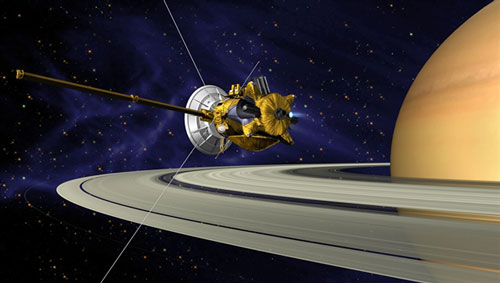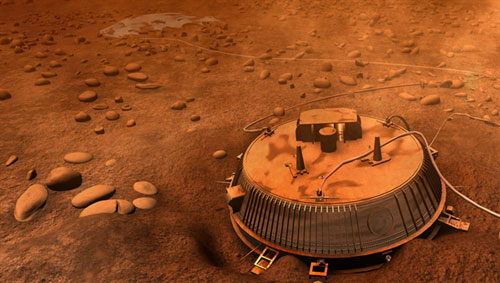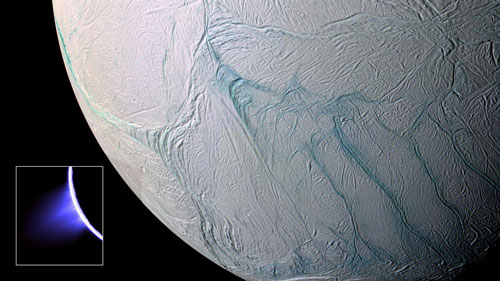| Jul 08, 2014 |
The Cassini orbiter - orbiting the icy world of Saturn for 10 years
|
|
(Nanowerk News) Cassini, the Saturn orbiter, has witnessed countless fascinating phenomena, transmitting exceptional images and measurements back to Earth – including the intricate structure of Saturn's rings, the fountains of ice shot into space from the surface of Enceladus and rivers and oceans of methane on Titan. This Methuselah among space explorers, designed to explore celestial bodies in the far reaches of the Solar System, has been circling Saturn for 10 years. The German Aerospace Center (Deutsches Zentrum für Luft- und Raumfahrt; DLR) has been involved in the NASA mission to the second largest of the eight planets from its very inception.
|
 |
| Cassini in orbit around Saturn.
|
|
"Saturn resembles the Solar System in miniature," explains Ralf Jaumann from the DLR Institute of Planetary Research. "Cassini and Huygens, its European daughter craft that landed on Titan, have provided us with fundamental insights into the development of the Solar System."
|
|
The six-ton spacecraft arrived at the ringed planet in early July 2004. After a close fly-by of the tiny moon Phoebe, the orbiter performed a daring manoeuvre, decelerating hard in order to be placed into orbit around Saturn. The engineers at NASA steered the orbiter from its southerly arrival trajectory through one of the larger gaps between the rings and around the northern hemisphere for the first time. At this stage, as it made its way along the initial, elongated ellipse, the gas giant planet's gravitational field captured Cassini, which became Saturn's first artificial satellite on 1 July 2004.
|
|
Planetary researchers at DLR are mapping the large icy moons
|
|
From that moment, the research programme focused on exploring the planet, its rings and over 50 moons. The DLR planetary researchers in Berlin-Adlershof have been mainly concerned with the latter, using the high-resolution camera images provided by Cassini to map the icy moons Rhea, Dione, Iapetus, Tethys, Mimas, Enceladus and Phoebe. The DLR cartographers have created atlases of these satellites, making a crucial contribution to their ongoing exploration.
|
 |
| Huygens landing craft on Saturn's moon Titan.
|
|
Only Titan, the largest of Saturn's moons, remains hidden from the inquisitive gaze of Cassini's camera. With a diameter of 5150 kilometres, it is the second largest moon in the Solar System (following Jupiter's moon Ganymede). Its dense atmosphere, made up of nitrogen and hydrocarbons, does not allow acquisition of sharp images of its surface. However, radar and infrared spectrometers are able to record signals from the moon's exterior. The European Space Agency (ESA) developed the Huygens lander specifically for the analysis of Titan. On 15 January 2005, suspended on parachutes, it drifted down through the alien atmosphere and touched down on the moon's icy crust, which was at a temperature of minus 180 degrees Celsius. This landing was a milestone in the history of unmanned space exploration.
|
|
Rain and lakes of hydrocarbons
|
|
Liquid methane and ethane rain down from the icy clouds enshrouding Titan; these hydrocarbons liquefy at a temperature of minus 182 degrees Celsius. The Huygens lander discovered an intricately branched system of valleys during its landing approach, showing precipitation flowing across the surface of Titan and collecting in basins to form smooth lakes. During the years that followed, DLR planetary researchers analysed reflections in the infrared spectral range, identifying a region in Titan's northern hemisphere that acted like a mirror – the first lake found on another Solar System body, filled with liquid hydrocarbons – a minor scientific sensation. The scientists at DLR also succeeded in identifying river systems that had carved valleys into the surface, pouring out into vast stretches of smooth liquid and collecting in basins. "We now know that there is methane and ethane rain, depending on the season, which flows across the surface and evaporates," explains Jaumann. "The river cycle on Titan is essentially the same as that on Earth. Due to the extremely low temperatures, it all takes quite a bit longer; of course, this applies equally to the resulting chemical processes."
|
|
Fountains of icy volcanic activity on Enceladus
|
|
One of the most intriguing discoveries was made about one of the smaller moons in orbit around Saturn – Enceladus, which is just 500 kilometres in diameter. Water is forced out of cavities beneath the icy surface and ejected in fountain-like plumes. The processes responsible for producing the pressure that causes this are not fully understood; because of its small size, Enceladus should be completely frozen. When the water droplets – which are emitted from fissures that stretch for several hundred kilometres in the south polar region – emerge, they freeze and most of them fall back down to the surface as small flakes of ice. However, some escape the moon's weak gravitational field and 'feed' the 'E ring' that encircles Saturn at the outer edge of its ring system.
|
 |
| The fountains of Enceladus.
|
|
The existence of a water reservoir beneath Enceladus' icy crust gives this moon a place in the short list of bodies in the Solar System that are likely to have water trapped beneath an icy crust. In addition to Enceladus, other members of this list are Titan and the Jovian moons Ganymede and Europa, as well as the dwarf planet Ceres. Jaumann says: "This makes these moons interesting when it comes to the question of where else in the Solar System, apart from Earth, life developed – at least in a primitive form. Mars – at least at one stage of its development – was also home to a large quantity of water. As usual in this kind of fascinating mission, the outcome has been a vast amount of knowledge and a lot of new questions. This mission remains unique, and we are unlikely to see something on this scale again." Nevertheless, ESA is currently preparing a similar, albeit smaller, project scheduled for the next decade. The Jupiter ICy moons Explorer (JUICE) is designed to explore Jupiter and its largest moons. It is scheduled to launch in 2022 and arrive in 2030.
|
|
The Mission
|
|
In the 10 years since the mission started, the roughly 250 scientists directly involved in the mission and their teams have researched Saturn, its rings and moons from all possible perspectives. NASA will keep the mission running until 2017, when the orbiter is scheduled to plummet into the planet's cloudy atmosphere. The Cassini-Huygens mission is a joint project between NASA, ESA and their Italian counterpart, ASI. The Jet Propulsion Laboratory (JPL) in Pasadena (California) runs the mission on behalf of the NASA Science Directorate. JPL also designed, developed and built the Cassini orbiter.
|
|
The German participants in the scientific side of this mission are DLR, the Max Planck Society (Max-Planck-Gesellschaft; MPG), several universities and the German aerospace industry. Germany's main contribution to the experimenten conducted on board the Cassini orbiter consists of providing the Cosmic Dust Analyser (CDA), used to examine tiny particles in space. The dust analyser measures the electrical charge, velocity, trajectory, mass and chemical composition of the particles. The mechanical components of the instrument were made at DLR in Berlin.
|



